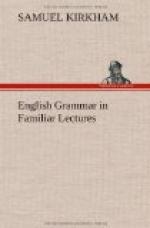4. The first he, in the seventh example, is, in the opinion of some, nom. to can hear understood; but Mr. N.R. Smith, a distinguished and acute grammarian, suggests the propriety of rendering the sentence thus; “He that formed the ear, formed it to hear; can he not hear?” The first he, in the last example, is redundant; yet the construction is sometimes admissible, for the expression is more forcible than it would be to say, “Let him hear who hath ears to hear;” and if we adopt the ingenious method of Mr. Smith, the sentence is grammatical, and may be rendered thus; “He that hath ears, hath ears to hear; let him hear.”
EXERCISES IN PARSING.
Idioms, anomalies, and intricacies.
1. “The wall is three feet high.” 2. “His son is eight years old.” 3. “My knife is worth a shilling.” 4. “She is worth him and all his connexions.” 5. “He has been there three times.” 6. “The hat cost ten dollars.” 7. “The load weighs a tun.” 8. “The spar measures ninety feet.”
REMARKS.—Anomaly is derived from the Greek, a, without, and omales, similar; that is, without similarity. Some give its derivation thus; anomaly, from the Latin, ab, from, or out of, and norma, a rule, or law, means an outlaw; a mode of expression that departs from the rules, laws, or general usages of the language; a construction in language peculiar to itself. Thus, it is a general rule of the language, that adjectives of one syllable are compared by adding r, or er, and st, or est, to the positive degree; but good, better, best; bad, worse, worst, are not compared according to the general rule. They are, therefore, anomalies. The plural number of nouns is generally formed by adding s to the singular: man, men; woman, women; child, children; penny, pence, are anomalies. The use of news, means, alms and amends, in the singular, constitutes anomalies. Anomalous constructions are correct according to custom; but, as they are departures from general rules, by them they cannot be analyzed.




